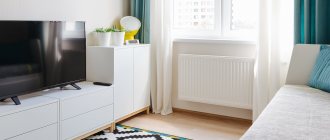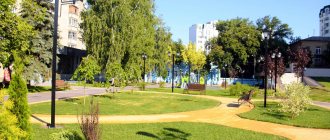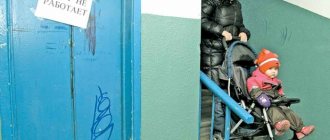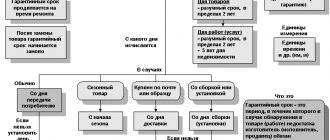Author of the article
Yulia Kuprina
Certified lawyer. Total work experience in the specialty is 13 years.
When the outside temperature is low, every living space in an apartment building must be heated. There are clear norms for apartment temperature during the heating season. We’ll figure out how to measure it correctly, what to do if it’s cold in the apartment, where to go in this case and what compensation to expect.
Regulatory acts
There are no separate laws and regulations governing heating in an apartment building. However, there are several regulations that regulate the temperature in the apartment during the heating season:
- GOST R 51617-2014, replacing the invalid GOST R 51617-2000. This document, effective July 1, 2015, forms a general system for the management and maintenance of residential buildings, and also establishes the provision and standard technical condition of such houses, their safe operation and determines comfortable living conditions. It also determines the obligation to comply with the requirements of technical regulations, sanitary and epidemiological requirements, the requirements of the Housing Code of the Russian Federation and other legal acts. You can download it HERE.
- GOST 30494-201, which establishes microclimate standards in children's institutions, public, administrative and household buildings, establishes general requirements for permissible indicators and air quality. You can download it HERE.
- SanPiN 2.1.2.2645-10, which establishes mandatory sanitary and epidemiological requirements for residential premises that must be observed during construction (reconstruction), design, and use of residential buildings and premises intended for permanent residence. It should be noted that the document will soon lose its force from March 2021 due to the publication of Decree of the Government of the Russian Federation dated October 8, 2020 No. 1631. You can download it HERE.
Based on seasons
Heat supply to apartment buildings begins and ends according to established schedules, depending on the seasons and regulatory requirements.
in winter
In the cold season, the number of degrees according to readings is always less than in summer. For residents of central Russia, the normal temperature in an apartment in winter should not be below +20 °C (+22 °C for corner apartments).
Heating is turned on when a steady cold snap occurs (with a temperature below +8 ° C) for five days.
Read also: At what temperature will the heating be turned on?
During the heat
With the onset of summer time, the comfortable temperature in the apartment can vary from +22 °C to 28 °C in rooms of different uses.
Overheating should not be allowed, as this not only affects a person’s well-being, but also causes the appearance of microorganisms in the room.
For newborns
When a baby arrives in the house, the regulatory requirements for temperatures change slightly. Pediatricians advise adhering to the optimal regime in the nursery within the range of +18 °C to +20 °C. At these values the child is comfortable. Too hot and dry air, on the contrary, interferes with the baby’s breathing and leads to the appearance of dry crusts in the nose.
The delicate skin of a baby sweats in a hot room, which is why it becomes covered with diaper rash, since it is not able to quickly remove excess moisture. The crib should also be located away from direct exposure to cold air flow - a window or air conditioner.
For the baby’s comfort you need:
- in hot weather or with strong heating, open windows more often to ventilate the child’s room,
- in the warm season, give the baby fluids and baths more often,
- cover too hot radiators with thick fabrics to retain heat.
Beginning and end of the heating season
The heating season in most regions of Russia starts on October 1-15. But this is an approximate date. Heating must be turned on when for five days in a row the average daily temperature outside remains below +8 degrees Celsius. It is not prohibited to start the heating season earlier, at the discretion of municipal authorities.
The batteries are turned off at the end of April - in May, when the average daily temperature remains above +8 degrees for five days.
Temperature standards for apartments according to GOST and SanPiN
Temperature standards in residential premises according to GOST and SanPiN:
- The optimal temperature is an indicator that, with prolonged exposure, a person does not experience discomfort.
- Permissible temperature is an indicator (maximum or minimum threshold), with prolonged exposure to which a person may experience discomfort, health may deteriorate, and performance will decrease, but no obvious deterioration in health occurs.
General temperature standards are as follows:
- During the heating season:
- optimal temperature – 20-22°C;
- permissible temperature – 18-24°C.
- In summer time:
- optimal temperature – 22-25°C;
- permissible temperature is 20-28°C.
The minimum heating standards in an apartment by room during the heating season are as follows:
- temperature in the corner room – 20°C;
- for the kitchen – 18°C;
- for the bathroom – 18°C;
- for the pantry – 12°C;
- lobby – 16°C;
- for a living room – 18°C;
- toilet – 18°C;
- inter-apartment corridor – 16°C;
The difference between corner apartments and apartments located in the middle of the house is that the area of their walls bordering the street is much larger. Builders are required to install additional radiators here, and the wall must be insulated. Therefore, current regulations determine the minimum temperature for a corner apartment (corner rooms) to be 20°C.
At night (from 24.00 to 5.00) the permissible temperature is 3 degrees lower.
The temperature in the apartment should not fall below these indicators. If this happens, action should be taken. Algorithm of actions:
- To make sure that the temperature is low, you need to measure it correctly.
- Contact the housing and communal services organization.
- If measures are not taken, contact the regulatory authorities - the housing inspectorate, the prosecutor's office and/or the court.
- Representatives of the resource supply company are required to carry out control temperature measurements.
- If it is really low, then utility companies are obliged to take measures (for example, fix a malfunction in the heating system) and assign monetary compensation to the apartment owner.
How not to harm your health
It would seem that the difference in the standards for the number of degrees in rooms is not so great, but a constant lack of heat or its excess can lead to negative effects on the human body.
Risks of overheating and hypothermia
Too hot and dry air inside a living area can cause the appearance of various types of bacteria that cause many infectious diseases.
In addition, in a stuffy environment, a person sweats and loses a lot of moisture, which negatively affects the functioning of the cardiovascular and nervous systems. At the same time, the skin becomes dry and lifeless, and the body’s fatigue increases.
Prolonged exposure to a cold room causes a disease called hypothermia. At the same time, limbs freeze, blood vessels narrow, and problems arise with the respiratory system and nervous system.
How to measure the temperature in an apartment
To make a correct measurement of the temperature in the apartment, you need to:
- Make sure there are no drafts or open windows. Wide open windows and interior doors significantly cool the room, so taking measurements under such conditions will not be objective. Very often it is a draft that causes a drop in temperature, and not cold radiators in the apartment.
- Ensure correct operation and installation of measuring instruments. You can use a regular room thermometer, which should be installed at a distance of at least one meter from the radiator and at least one and a half meters in height from the floor.
- Measure the temperature several times. Measurements made once are considered not objective.
- Select weather conditions. Measurements made in warm, sunny weather or weather that is not typical for the season (sharp warming or cooling) are also not considered reliable. Therefore, it is recommended to choose a cloudy, cool day to measure the temperature.
- Measure the temperature in several rooms at once. Measurements must be taken in different rooms.
Using these simple rules, you can independently measure the temperature in your living room. If it does not comply with the standards, contact the appropriate authorities.
How to take measurements correctly?
If residents have doubts that their apartment is heated sufficiently, they are required to take measurements (do not check their concerns yourself, and subsequently the measurements will be carried out by members of the commission).
This is done according to certain standards:
- Measurements must be taken over a full day.
- Readings must be taken once an hour.
- The thermometer should be located no closer than 1 meter to the external walls of the building.
- The thermometer is located at a height of 1 - 1.5 meters from the floor.
All results must be entered into a report drawn up in two copies.
They are signed by the consumer and a member of the commission, and one of the copies is handed over to the resident.
It happens that the user has identified underheating of hot water or air, but when a specialist comes, his control measurements are different and fall within the standards. The reason may be the errors of the thermometers (for different types of devices this can be from 0.5 to 2 °C).
But if you have doubts about the correctness of the readings, ask for a certificate of conformity for the thermometer. If such a document cannot be provided, the report can indicate: “I do not agree with the results of the inspection due to the lack of a certificate for the thermometer.”
Possible causes of low temperature
Reasons why the air temperature in the apartment can be significantly reduced:
- Incorrect design during the construction of the entire house, when the heating system does not cope with the task. Or building codes were violated.
- Gaps in windows, doorways, balcony frames; the balcony is not insulated.
- Draft.
- Insufficient wall thickness, at which freezing occurs and, as a consequence, a decrease in temperature standards in the living room.
- If the apartment is on the ground floor, there may be basements with storage rooms underneath, which require constant ventilation. And then the best solution is to install a “warm floor”.
- Deterioration of the heating system in the house.
- Location of the room. In winter, a corner apartment and an apartment on the ground floor will always be a little cooler than an apartment located in the center of the house.
- Incorrect operation of the heating system, for example, air lock in the batteries.
- The heat supply is not at sufficient temperature, the batteries are barely warm. We are talking about a service of inadequate quality and a violation of heating standards.
- Repair work in case of accidents in the cold season, during which the temperature in the battery can significantly decrease.
What factors influence
The microclimate in the house is influenced by both external and internal factors. External factors include the location of the premises, the change of season, the technical parameters of the structure, humidity and atmospheric air pressure.
Subjective factors largely depend on the residents themselves. People are able to independently maintain comfort in their home by performing a number of specific actions in a timely manner.
So, to save heat, it is enough:
- Replace old frames with energy-saving double-glazed windows or carefully seal cracks in old structures.
- If necessary, insulate the walls of corner rooms.
- Lay a warm floor covering or install heated floors.
- Add a heat reflective screen to the wall next to the radiator.
- Do not cover radiators with furniture or thick curtains.
- If possible, insulate the loggia and front door.
Climate
The start dates of the heating season over the vast area of Russia differ greatly depending on latitude. To draw up heat supply schedules, average winter time values are taken from a special temperature table. For the southern territories they are one, and for the northern territories they are different.
For example, in the Nenets Autonomous Okrug the heating season begins in September, and in the Moscow region - only in early October. In the Krasnoyarsk Territory and Chukotka, residents will begin heating their apartments at the end of August. For residents of the Black Sea coast, heat is supplied for only three months, starting in December.
There are places in the Russian expanses where it is necessary to warm up houses throughout the year, for example, on the polar island of Dikson.
Season
The change of season also affects the microclimate of the home. With the onset of dank and rainy autumn weather, the walls of houses heated over the summer gradually cool down. In the spring, when the heating is turned off, room thermometer readings also decrease.
Building Features
The technical characteristics of the building, its thermal insulation, materials - all this affects the microclimate of the home. For example, each additional corner in the house is a separate cold area that requires additional heating.
A brick building is warmer than a panel building with seams, and wooden houses not only keep heat well in winter, but also provide pleasant coolness in the summer.
Human factor
The human factor plays an important role when choosing a comfortable thermal regime. For example, some people prefer a warmer atmosphere, while others prefer cooler air.
Many people open their windows to bring in fresh air even in the winter months, and use air conditioning in the summer heat. This lowers the degrees by several units.
How and where to complain
If, during independent measurements, a discrepancy between the temperature conditions in the apartment and the accepted standards is discovered, you can submit a statement:
- To the emergency service with the appropriate application.
- To the management company with a corresponding application in writing.
If there is no response from the management company or service organization, you should contact the regulatory authorities:
- To the State Housing Inspectorate with a complaint about the supply of services of inadequate quality and attaching the following documents: - copies of an application to the management (service) organization with a complaint about inappropriate temperature in the apartment; — a copy of the refusal (if one was received) from the service organization; - copy of passport; - other documents relevant to the case.
- To the Prosecutor's Office with the necessary documents attached.
You can now contact regulatory authorities not only in person or through Russian Post, but also using the State Services website, if you are registered there.
To do this, you need to log in to the State Services website, go to the “Authorities” section and find the prosecutor’s office of your region there. Then choose a service for submitting citizens' appeals to the prosecutor's office of the Russian Federation. And fill out the application form. The answer will come to your personal account within 30 days.
As a rule, regulatory authorities force service companies to work quickly and provide them with documents stating that the temperature in the apartment is normal.
✅ Permissible deviations from the norm
In another way, the permissible air temperature is called permissible deviations from the norm. It is these deviations that the emergency dispatch service of the housing and communal services, HOA or management company refers to when drawing up reports of violation of the temperature regime in the apartment.
The permissible air temperature should be:
- 18-24 °C in the living room;
- 20-24 °C in the living room, in areas with the coldest five-day temperature -31 °C;
- 18-26 °C in the kitchen;
- 19-21 °C in the toilet;
- 18-26 °C in a bathroom or combined toilet;
- 20-20 °C in corner rooms.
Responsibility of utilities
After receiving a complaint, representatives of the resource supply company must notify the subscriber of the date and time of temperature measurements in the apartment. At this point, the applicant is obliged to ensure his presence and admission to the apartment.
Based on the results of measurements, a report is drawn up describing all the parameters. One copy of the act is given to the applicant against signature, the second is stored in the resource supply company.
If it is confirmed that the temperature in the apartment does not meet the norm during the heating season, the resource supplying organization is obliged to make a recalculation for the entire period of supply of services of inadequate quality in accordance with the conditions of clauses 101, 111, 112 of the Rules, approved by Decree of the Government of the Russian Federation dated 05/06/2011 No. 354 (hereinafter referred to as Rule 354).
Battery operating parameters and procedure for measuring their temperature
To determine compliance with the legally permissible temperature in the apartment during winter, it is necessary to check the operation of the batteries. They should be periodically monitored to establish the validity of housing and communal services tariffs.
Standards for water pressure (pressure) in an apartment are defined within the following limits:
- For cold water - from 0.3 to 6 atmospheres
- For hot – from 0.3 to 4.5 atmospheres
There are no regulations governing the minimum temperature of radiators. In this case, the maximum limit for heating batteries is set, defined in SNiP 41-01-2003.
- If the heating system is two-pipe, then the radiator should not heat up above 95 degrees
- When the system is single pipe, the limit is 115 degrees
The recommended range is also set - from 85 to 90 degrees.
To establish deviations from the permissible temperature norm and achieve recalculation, it is necessary to measure the temperature of the radiators using one of the following methods:
- By applying a standard electronic thermometer to the surface of the battery (in this case, you need to add no more than 2 degrees to the readings)
- Using a heat meter that senses infrared radiation
- Using an alcohol-type thermometer (when taking measurements, it must be isolated from the environment)
Any of the devices used must have a certificate and passport, which contains the rules of use and error characteristics.
What compensation can you expect: formula and example
The procedure for making recalculation, as well as the formula, are prescribed in clause 101 of the “Rules for the provision of public utilities...” No. 354 and Government Decree No. 307 of May 23, 2006. When recalculating, the fee charged for the service is reduced by 0.15% for each degree. This amount is multiplied by the number of hours during which the temperature was below normal for a residential premises during the heating season.
Formula: Compensation amount = SxAx0.0015x(T norm. - T fact.)
Where:
S – heating fee – the full amount on the receipt for the period for which you want to receive compensation.
A – number of hours when the temperature was below normal
T is normal. – standard permissible air temperature
T fact. – actual temperature
Example. Heating fee per month – 4000 rubles. On December 1, you drew up a report stating that the apartment was 2 degrees colder than the standard, and handed the report over to the utility companies. But within 45 days (until January 14) there was no reaction. 45 days is 1080 hours. Payment for 1.5 months of heating – 6,000 rubles.
Compensation amount = 6000x1018x0.0015x2=19440 rub.
But there is a limitation: no matter how much compensation you calculate, it should not exceed the actual cost of heating. In this case, the compensation will not be 19,440 rubles, but 6,000 rubles, that is, the full payment for heating for one and a half months.
It is important to know that the recalculation period will begin from the moment a citizen files a complaint until the delivery of a service of inadequate quality is eliminated. That is, if measurements taken in December showed low temperatures, a recalculation for December was made, but it is still cold in January, you need to re-demand from the utility service provider a recalculation for the entire period of January.
Responsibility of housing and communal services and the management company for violation of temperature conditions
There are situations when the management company or housing and communal services organization does not have its own emergency service and does not comply with the heating shutdown deadlines. In this case, you can check the compliance of the air temperature in the apartment with the standards yourself and independently draw up an act, which must be signed by at least two consumers of utility services and the chairman of the building council. In this case, the document will have legal force and from the moment it is signed, you can count the time for the provision of poor-quality services, and therefore demand compensation for this.
If utility workers quickly respond to a complaint, there will be no consequences for them. Otherwise, residents will file a complaint with the state inspection authorities. As a result, utilities will be held accountable and fined for an administrative violation.
But if victims have evidence that the decrease in temperature in the house led to health problems, then they will be able to recover damages in civil court.
If serious consequences occur, a criminal case may even be initiated.
Arbitrage practice
Judicial practice on issues of compliance with temperature conditions and heating in apartment buildings is quite extensive and contains answers to key questions, failure to comply with which will entail a refusal to satisfy the subscriber’s requirements.
For example, in the Decision of January 24, 2021 in case No. 2-278/2017, the court refused to satisfy the subscriber’s requirements for recalculation due to the fact that all measurements taken, attached as evidence of exceeding permissible temperature standards, were compiled by the subscriber independently. Moreover, the subscriber in every possible way prevented representatives of the management organization from entering his apartment and did not allow them to take measurements.
But in the Ruling of the Supreme Arbitration Court of the Russian Federation dated April 11, 2012 No. VAS-3355/12 in case No. A03-1052/2011 on the refusal to transfer the case to the Presidium of the Supreme Arbitration Court of the Russian Federation, the court satisfied and collected from the homeowners’ association the debt for the supplied thermal energy for heating on the basis of , that the resource supply company provided documents indicating that inconsistencies in the temperature conditions in individual apartments were identified in the network, which is the operational responsibility of the homeowners association. In addition, no evidence was provided to show that there were clear reasons for the temperature deviation.
If the apartment is too cold, you need to contact utility services.
If they don’t react, then the regulatory authorities will. You may receive compensation for services of poor quality. Useful article? Rate and share with friends!
Optimal temperature for humans
Scientists have long discovered at what temperature a person feels most comfortable and can lead normal life activities.
On average, the room temperature should be 21–25 degrees.
The optimal temperature regime for each individual person depends on several indicators:
- Individual characteristics of the body
- Age
- Paula
- Lifestyle
Based on the research carried out, temperature standards for residential and work premises were adopted.









